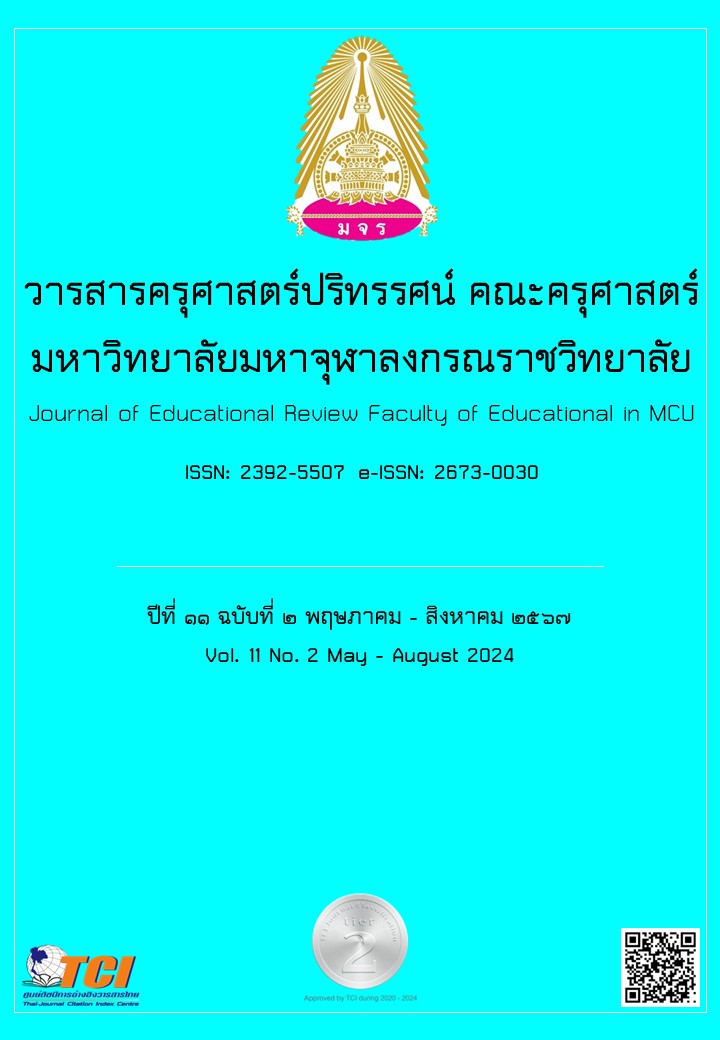VISIONARY LEADERSHIP BASED ON THE FOUR IDDHIPADAS AND MODERN EDUCATION
Main Article Content
Abstract
This article emphasized on the importance of visionary leadership for educational administrators in the current era, which was constantly facing changes and challenges. Executives needed to have a clear vision to lead the organization through obstacles and achieve its goals. Therefore, successful executives should have important qualities, namely, creating a clear and practical vision by integrating the four principles of influence into their work, namely, Chanda (contentment), Viriya (diligence), Citta (intention), and Vima s (contemplation). Visionary leadership that integrates the four principles of Iddhip da was an important tool in developing education in the current era. Executives with vision could create innovations and lead the organization to achieve its goals effectively.
Executives must also be good role models, be creative, and working as a team to inspire and develop personnel to their highest potential. Visionary leadership that integrated the four principles of Iddhip da was an important tool in developing education in the current era. Executives with vision could create innovations and lead the organization to achieve its goals effectively.
The article suggested that visionary leadership that was consistent with the four principles of influence would help executives in leading the organization to sustainable success, focusing on developing learners to be quality individuals with the skills necessary for living in the 21st century and to be able to cope with change effectively.
Article Details

This work is licensed under a Creative Commons Attribution-NonCommercial-NoDerivatives 4.0 International License.
ทัศนะและความคิดเห็นที่ปรากฏในบทความในวารสารฉบับนี้ถือเป็นความรับผิดชอบของผู้เขียนบทความนั้นเพียงผู้เดียว และไม่ถือเป็นทัศนะและความรับผิดชอบของกองบรรณาธิการ
กองบรรณาธิการขอสงวนสิทธิ์ในการคัดเลือกบทความลงตีพิมพ์และจะแจ้งให้เจ้าของบทความทราบหลังจากผู้ประเมินบทความตรวจอ่านบทความแล้ว
ต้นฉบับที่ได้รับการตีพิมพ์ในวารสารครุศาสตร์ปริทรรศน์ คณะครุศาสตร์ มหาวิทยาลัยมหาจุฬาลงกรณราชวิทยาลัย ถือเป็นกรรมสิทธิ์ของคณะครุศาสตร์ มหาวิทยาลัยมหาจุฬาลงกรณราชวิทยาลัย ห้ามนำข้อความทั้งหมดหรือบางส่วนไปพิมพ์ซ้ำ เว้นเสียแต่ว่าจะได้รับอนุญาตจากมหาวิทยาลัยฯ เป็นลายลักษณ์อักษร
References
นิกัญชลา ล้นเหลือ. (2554). โมเดลสมการโครงสร้างภาวะผู้นำเชิงวิสัยทัศน์ของผู้บริหารสถานศึกษาขั้นพื้นฐาน. ดุษฎีนิพนธ์ปรัชญาดุษฎีบัณฑิต. มหาวิทยาลัยขอนแก่น.
พระธรรมโกศาจารย์ (ประยูร ธมจิตโต). (2551). ทำอย่างไรจึงเรียนเก่ง. กรุงเทพมหานคร: โรงพิมพ์มหาจุฬาลงกรณราชวิทยาลัย.
พระธรรมปิฎก (ป. อ. ปยุตฺโต). (2546). พจนานุกรมพุทธศาสตร์ฉบับประมวลธรรม. กรุงเทพมหานคร: มหาจุฬาลงกรณราชวิทยาลัย.
พุทธทาสภิกขุ. (2537). การทำงานที่เป็นสุข. กรุงเทพมหานคร: ธรรมสภา.
มหาจุฬาลงกรณราชวิทยาลัย. (2539). พระไตรปิฎกภาษาไทย ฉบับมหาจุฬาลงกรณราชวิทยาลัย. กรุงเทพมหานคร: มหาจุฬาลงกรณราชวิทยาลัย.
วิชัย วงษ์ใหญ่ และมารุต พัฒผล. (2567). การเรียนรู้ในโลก VUCA สู่ Social Quotient. แหล่งที่มา http://www.curriculumandlearning.com/upload/Books/VUCA_1573117164.pdf สืบค้นเมื่อ 12 ก.พ. 2566.
ศิรินทรา กลักโพธิ์. (2555). การศึกษาไทยในอนาคต. แหล่งที่มา https://www.gotoknow.org/posts/479616 สืบค้นเมื่อ 11 ก.พ. 2566.
สุวิมล โพธิ์กลิ่น. (2564). นวัตกรรมการบริหารสถานศึกษายุคใหม่. วารสาร มจร อุบลปริทรรศน์. 6(3). 978.
เอกกวีร์ พิทักษ์ธนัชกุล. (2567). การศึกษาในโลกยุคปัจจุบัน. แหล่งที่มา https://www.stou.ac.th/study/sumrit/1-58(500)/page9-1-58(500).html สืบค้นเมื่อ 12 ธ.ค. 2566.
Bass, B.M. & Riggio, R. E. (2006). Transformational Leadership. 2 nd ed. Mahwah, N.J: Lawrence Erlbaum Associates.
Braun, J. B. (1991). An analysis of principal leadership vision and its relationship to school climate. Dissertations Abstracts International. 52(4). 25.
Fisher, K. (1993). Leading self-directed work teams. New York: McGraw-Hill Education.
Keller, R. (1992). Transformational leadership and the performance of research and development project groups. The Journal of Management. 18(3). 19.
Robbins, S. P. (2003). Organizational behavior: Concepts, controversies, applications. 10th ed. Hoboken: Prentice Hall.
Westley, F. & Mintzberg, H. 1989). Visionary leadership and strategic management. The Strategic Management Journal. 10(1). 98.


